How to Get New Feedlot Calves Settled and Gaining Quickly; Advice from Producers, Veterinarians and Feedlot Consultants
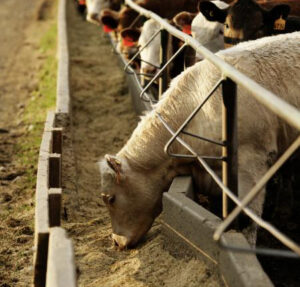
Getting calves settled, keeping them healthy and getting them gaining involves serious management that considers many variables. A successful program to keep these calves healthy and growing should involve co-operative consultation between the feeder, herd health veterinarian and the livestock nutritionist. Stress on calves is the number one offender and the degree of stress can vary widely between calves and loads of calves. If not managed properly, freshly weaned calves heading to a feed yard can be very susceptible to pneumonia and other illnesses.
While herd health veterinarians and feedlot production specialists can each have slightly different approaches to getting new feeders ramped up to the intended full-feed ration, all have a common starting point — get calves unloaded into a receiving pen, don’t over crowd them, make sure they have access to good quality grass hay, are drinking water, the lot is well bedded, and the cattle get a few hours of rest before processing.
It sounds like a simple enough plan when introducing newly weaned calves to the feed yard. But, to successfully get calves eating and gaining, ideally from day one, takes both planning and management.
Joyce van Donkersgoed
Veterinarian – Alberta Beef Health Services
Coaldale, AB
While more time would be better, Joyce Van Donkersgoed of Alberta Beef Health Services in Coaldale, east of Lethbridge, recommends calves have at least a few hours of rest in a well bedded receiving pen before being processed.
“The key is to get them eating as soon as possible,” says Van Donkersgoed. “They are tired after being trucked and most likely hungry and thirsty. At the receiving pen you don’t want them overcrowded. They should have access to as much good quality grass hay and fresh clean water as they wish, that is easily accessible. They should be allowed to eat, drink and rest for at least six hours, if practically possible, before being processed.”
While information is not always readily available, knowing some background on the calves can help considerably with management. “It helps if the feedlot can learn as much as they can about where the calves are coming from and how they’ve been raised and handled,” she says. “Are they coming directly from a ranch or auction mart? Were they still out on pasture? What were the pasture conditions? Was creep feed or loose mineral available? Vaccination history? That’s some of the information that can help the feedlot better manage calves when they do arrive. The more you know about the calves the better.”
If they are straight-from-the-ranch calves that have not been preconditioned, or pre-weaned the feedlot operator may need to show the calves the basics of finding food and water in a confined feeding pen. “Some operations use round bale feeders in the receiving pen while others only have a feed bunk. Make sure there is plenty of good quality grass hay and keep it fluffed up and visible so the calves can see it. It may be necessary to physically move calves toward the feeder, so they discover the hay.” She recommends having feed (hay) tested to ensure quality and help the nutritionist formulate a well-balanced ration.
It helps if the feedlot can learn as much as they can about where the calves are coming from and how they’ve been raised and handled. Are they coming directly from a ranch or auction mart? Were they still out on pasture? What were the pasture conditions? Was creep feed or loose mineral available? Vaccination history?
Van Donkersgoed says it is important to make sure feeders and water bowls are at the proper height so even the smaller calves can reach. If needed, she has used her hand to splash water and make some noise just so curious calves will come by and check out the water bowls. If feeding baled hay, make sure all twine is collected and removed. Even small bits of indigestible twine left behind by bale shredding equipment can be a hazard to calves and older livestock — it can ball up and plug their gut.
In years of widespread or even regionalized drought, it helps operators to know where calves are coming from as poorer pastures can result in mineral deficiencies in calves. Low levels of copper and selenium are two of the most common mineral deficiencies that can affect calf health and performance. Be vigilant; have your feed tested, including mineral analysis, and possibly mineral deficiency testing of incoming calves as required, to determine what is needed for a balanced ration and approach to get calves started on the right path for good health and performance in the yard.
Ken Schaus
Schaus Land and Cattle Co.
Elmwood, ON
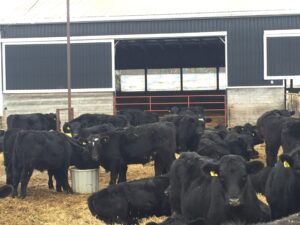
Proper planning and proper handling are the keys to getting long-haul calves from western Canada to Ontario in good condition and ready to grow, says Ken Schaus of Schaus Land and Cattle Co. at Elmwood, ON.
After nearly 50 years in the business as Ontario order buyers bringing western calves some 2,000 kilometres to the Schaus feedlots as well as customer feed yards, Schaus says it doesn’t pay to take any shortcuts.
“You can overload the trucks, you can skimp on bedding and maybe save a few dollars here and there but that’s where the wrecks happen,” says Schaus. “It’s a long trip for example from Moose Jaw, SK to our yard here in Ontario but if calves are transported properly, and then introduced to new rations properly they won’t miss a beat in terms of gain.”
Schaus says while it takes proper management to introduce new calves to backgrounding and finishing rations, it all starts with getting them transported in good condition.
Schaus Land and Cattle sources hundreds of liner loads of calves from Western Canada each year for feeder customers across Ontario as well as their own two feed yards.
While they pick up cattle from various points, a typical example is to assemble fresh-weaned ranch cattle or calves from a Saskatchewan pre-sort sale.
The program to get healthy, vigorous calves delivered to Ontario often begins at the ranch, he says. “The ideal calf, is to find those that have been vaccinated for both IBR and eight-way at the ranch and they have some idea of what a water bowl and dry feed such as pellets or chopped hay looks like.”
The next step is a smooth trip east across the Canadian Shield. “Say we have three truck loads of calves coming from Moose Jaw,” he explains. “We know the number of head, have the trucks lined up and ready at the assembly yard, and they are bedded with 30 bales of straw…not six, not 10 but 30. It’s a long trip and we want calves as comfortable as possible.”
Schaus doesn’t want calves crowded either. If he has 50,000 pounds of calves to move, for example, he’ll book and pay for 60,000 pounds of truck capacity just so they have some room. As soon as calves are assembled, they are loaded and head out for the 1,200 km leg east to the first stop in Thunder Bay. At Thunder Bay’s long-established feed and water station calves are unloaded for at least an eight to 10 hour rest, given food and water. Trucks are re-bedded as needed and after rest calves re-loaded. Again, comfort and protection are important. Calves may be leaving -20°C temperatures in Saskatchewan, he says to arrive in Elmwood where it might be +10°C and misty — a significant change in environmental conditions.
We know the number of head, have the trucks lined up and ready at the assembly yard, and they are bedded with 30 bales of straw…not six, not 10 but 30. It’s a long trip and we want calves as comfortable as possible.
“It’s exactly a 24 hour trip from Thunder Bay to our yard,” says Schaus. “We don’t want calves arriving in the middle of the night, so we aim for the trucks to leave Thunder Bay at 6 or 7 a.m. and the next morning they are in our yard.”
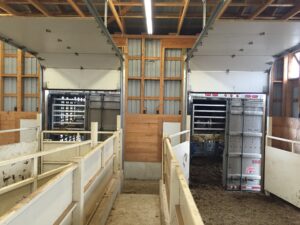
Calves are offloaded, tagged and processed immediately. Schaus says when he is able to source those “ideal” calves and he is confident in their vaccination program prior to sale, he provides booster shots as needed. If the vaccination protocol is unknown, new arrivals are tagged and given a full vaccination program, including a long-acting antibiotic such as Draxxin to reduce the risk of calves being affected by Bovine Respiratory Disease. “Our biggest concern is to build their immunity as soon as possible,” he says. If dehorning or castration is required, calves are given pain control medication before being processed.
As the calves arrive in Ontario backgrounding feed yards shortly after processing, the first starter ration usually includes good quality grass hay (timothy and orchard grass), three to four pounds of protein pellets and sometimes a bit of molasses to encourage calves to eat. There are permanent waterbowls, but at Schaus feed yards extra water troughs will also be brought right into the yard just so calves have plenty and easy access to water.
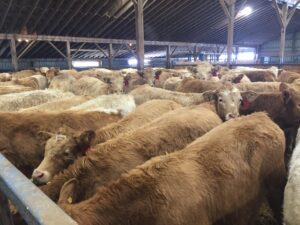
While some Schaus customers have feed yards, most calves are housed and fed in barns or shelters and will remain on the mostly hay-based diet until they are familiar with feed and surroundings.
“The emphasis is to provide calves with a largely dry ration with minimal changes for the first 20 days until feed intake is stable and high,” he says. Around the 20-day mark some silage ration is added to the bunk along with the hay diet to see if calves are interested. Day 3 the amount of silage is increased and Day 4 it is mixed with the hay. “It just makes a nice transition to the silage ration,” says Schaus. “It is a bit like feeding sauerkraut to a baby. You need to ease them into it.”
Schaus says with proper transport and feed management of new calves, they will transition to a full backgrounding or finishing ration with ease.
Steve Hendrick
Veterinarian – Coaldale Veterinary Clinic
Coaldale, AB
Steve Hendrick, veterinarian with Coaldale Veterinary Clinic east of Lethbridge likes to see freshly weaned calves have at least a day of rest at the feedlot before being processed.
“If they are auction mart calves I would recommend at least 48 hours of rest before processing,” he says. “And if they are cold weaned ranch-direct calves I would increase that to preferably four days of rest before being processed. Some research has shown that having sufficient rest may help to improve the efficacy of treatments when they are processed.” He also says it is important to have properly trained feedlot workers to minimize handling stress.
Effort should be made to encourage calves to find the feed bunk and the water, says Hendrick. For the first three days after arrival fresh hay can be placed on top of fresh silage ration “so they have to nibble through the hay to find the ration.” And while pens should be properly bedded, especially if conditions are cold and/or wet, it becomes a management balance to ensure calves gravitate toward the hay for feed and don’t just eat straw.
After three days, as the calves transition to more of a silage-based ration some grain is needed to provide energy, but at the same that ration shouldn’t be “hot”. A hot ration generally refers to a ration with a high grain component and not enough fibre. As grain is rapidly digested in the rumen it converts starch to acid. Without forage fibre to buffer the acid the increased acid is then absorbed through the rumen wall, causing metabolic acidosis, which in milder cases can put cattle off feed and result in weight loss, while in severe cases can lead to shock and death
It is important to have properly trained feedlot workers to minimize handling stress.
Bob Lowe
Bear Trap Feeders
Nanton, AB
With young calves coming into the feedlot, possibly from several different sources, Bob Lowe says his priority is to make sure they have feed “and do everything possible to make the transition as smooth as possible.”
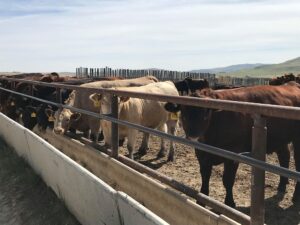
Lowe, owner of Bear Trap Feeders at Nanton, AB, about 100 km south of Calgary says the first order of business is to get calves vaccinated, fed and rested.
“The biggest challenge you face is that these calves have been taken away from an environment where they had their mother, milk and grass and you’re putting them in a setting where they have none of that,” says Lowe. “They are stressed and tired, so you try not to do anything that’s going to add to that.”
From processing, calves are moved to a feed pen with a large round bale of good quality grass hay, water is accessible and there is already a forage ration in the feed bunk as well.
“We want them to have a full belly and get rested,” says Lowe. “They can eat and lay in the hay and I’ve seldom had any problem with calves finding the water bowl. If it is a concern we keep them pushed up toward the water, and once they see one drinking the rest will follow.” Lowe tries not to overcrowd calves — give them space to eat, rest and become familiar with new surroundings.
“That bale of hay is the last hay they will see in our yard, so we begin probably that first day to encourage them to find the feed bunk as well,” says Lowe. He says quiet handling is important as calves are moved to the bunk area to discover the new type of feed. The starter ration is a combination of silage, straw, as well as some barley. “They have hay and they’re eating, but you encourage them to find the bunk and start picking away and learn to like the ration as well.”
“We’re expecting by day four or five these calves should be eating two to 2.5 per cent of their body weight,” says Lowe. Depending on weight gain goals, the ration will be adjusted from there.
Matt May
Feedlot Nutrition and Production Consultant
Feedlot Health Management Services
Okotoks, AB
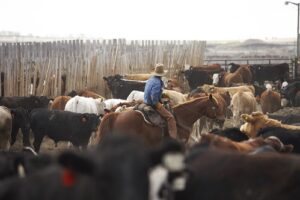
Knowing as much as possible about the background of calves arriving at the feed yard will help managers understand risk levels and apply appropriate handling and processing measures, says Matt May, feedlot nutrition and production consultant with Feedlot Health Management Services in Okotoks, AB.
If hay is an option calves should have hay available for the first three to four days after arrival and as they move into their home pens, he says. He prefers to have the hay topped with ration so they become familiar with silage and grain from the start. Again, pen checkers need to be paying attention from the outset to make sure calves are finding hay and water and becoming familiar with the feed bunk and waterers.
With most feed yard pens holding between 200 to 300 head, May prefers to close a pen off to new arrivals after no more than seven days. “Within that first week the first calves in will become familiar with the bunk, their pen mates and the first level of ration so if at all possible I don’t want to be adding new fresh calves to that pen after a week,” he says.
After new arrivals have had about three to four days of largely a forage-based diet, May recommends removing top-dressed hay from the diet and provide calves with the starter diet primarily based on small-grains silage-based ration with some grain for energy.
Over the next 25 to 30 days he will transition calves to a new ration about every five to seven days. “They will be on their first ration for about five to seven days after the pen is closed, for example, then transition them to the next ration which generally means replacing 10 per cent of the forage component with 10 per cent more concentrate,” he says.
By 10 to 14 days calves should be eating about 1.5 to 2 percent of their bodyweight. If calves are on a finishing ration they should be on their full finishing ration by about day 30.
By 10 to 14 days calves should be eating about 1.5 to 2 percent of their bodyweight. If calves are on a finishing ration (as opposed to backgrounding) they should be on their full finishing ration by about day 30.
“It is important through all stages — from bringing new calves into the yard, right through to finishing — that discussions involve the producer, the veterinarian and nutritionist just so everyone is on the same page in terms of expectations and goals,” says May. “While it is important to have a plan, if challenges occur, which will occur, then everyone can respond and look at the options available.”
Click here to subscribe to the BCRC Blog and receive email notifications when new content is posted.
The sharing or reprinting of BCRC Blog articles is welcome and encouraged. Please provide acknowledgement to the Beef Cattle Research Council, list the website address, www.BeefResearch.ca, and let us know you chose to share the article by emailing us at [email protected].
We welcome your questions, comments and suggestions. Contact us directly or generate public discussion by posting your thoughts below.